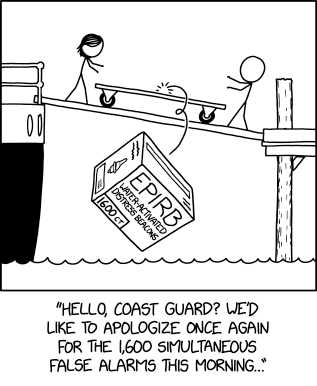EPIRBs

'Oh no, the box is drifting out into the harbor!' 'Yeah, I wouldn't worry about losing it.'

'Oh no, the box is drifting out into the harbor!' 'Yeah, I wouldn't worry about losing it.'
An emergency position-indicating radiobeacon (EPIRB) is a maritime safety device that, when it comes in contact with water, sends a distress signal via satellite. This signal is detected by search and rescue organizations such as the United States Coast Guard so that they can dispatch a rescue team. An EPIRB's purpose is to automatically notify such authorities of emergencies at sea, such as a ship sinking when it is out of range of normal radio communications and/or where those affected may not be able to reliably communicate their plight and correct location.
In the comic Megan and Cueball accidentally drop a box containing 1,600 EPIRBs into the water while moving it across a gangway between a ship and a dock. Because EPIRBs automatically activate when immersed in water, and apparently the crate contains fully enabled units not otherwise held within waterproof packaging, the result would be 1,600 simultaneous signals of a ship sinking. In reality, though, EPIRBs usually require some sort of pre-activation and would not be in an operable state when packaged in transit and prior to sale or installation on a vessel. The text beneath the comic is them calling the Coast Guard to apologize for the overwhelming flood of signals. It appears this is not the first such call they have made, though it is unclear whether they have called multiple times to apologise for the same incident, or they are habitually careless in their handling of these packages.
The automatic nature of EPIRBs could allow such an overload if a package of them were dropped in water, and it would cause difficulty for a search and rescue group to receive so many signals at once. Not only that, but Cueball and Megan would likely be fired for gross negligence, causing severe financial penalties (which can be as much as $5,000 an hour for rescue assets, potentially reaching hundreds of thousands or millions of dollars for a major incident), safety violations, disruption of operations and legal consequences like significant civil fines and even criminal penalties if the actions were deemed willful or due to a reckless disregard for safety and the law.
It is very unlikely the Coast Guard would mount a full search and rescue response. Seeing 1,600 simultaneous signals inside of a port, potentially even reporting a position on land given how close they are to the dock, would make it immediately clear the signals were some kind of mistake or glitch. If this is a major port the Coast Guard could just look out the window to confirm that hundreds of ships are not sinking in the harbor at once. However, the massive flood of signals could affect the response to other, legitimate, emergencies by overwhelming the communications channels. Sources[actual citation needed] suggest that each satellite can handle 10 to 90 beacons at once in its field of view, so 1,600 would clearly clog the bandwidth. Even if all 1,600 signals made it through, taking just a few seconds to acknowledge and clear/delete them would mean an hour or two to remove all 1,600 signals, during which time a legitimate signal could go unseen. Combining both scenarios - the system only reports 90 signals from the satellite overhead, then several minutes later, after they are cleared or a new satellite comes overhead, 90 new reports are generated and need to be cleared - could clog the reporting system for many hours.
The title text notes that, because EPIRBs continuously broadcast their location (particularly modern GPIRBs with a GPS feature to provide an actual location and not just a signal to home in on), there is no reason to worry about the box floating out of the harbor and getting lost, because (even if it does float out of the harbor) there is no risk of "losing" it - the box is essentially a 1600N-redundant self-locator.